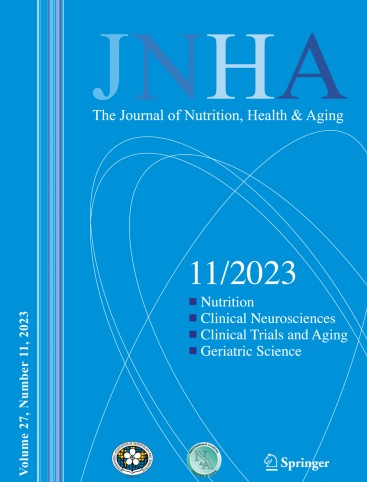Malnutrition risk as a predictor of quality of life and skeletal muscle depletion following upper gastrointestinal cancer diagnosis: A longitudinal analysis
IF 4
3区 医学
Q1 GERIATRICS & GERONTOLOGY
引用次数: 0
Abstract
Objectives
Low skeletal muscle index (SMI) and radiodensity (SMD) are established prognostic indicators in cancer. This study investigated risk factors for low and decreasing SMI and low SMD in upper gastrointestinal cancer and examined the influence of malnutrition risk on the association between SMI and health-related quality of life (HRQOL).
Design
Longitudinal analysis of randomised controlled trial outcome data.
Setting
Three health services in Victoria, Australia.
Participants
Adults newly diagnosed with oesophageal, gastric or pancreatic cancer.
Measurements
Outcomes assessed at diagnosis, and three- and six-month follow-up. SMI and SMD were assessed via computed tomography imaging analysis, with low values determined using established sex-specific thresholds. Malnutrition risk was assessed using the Patient Generated Subjective Global Assessment (Short Form), and HRQOL with the EORTC QLQ-C30. Multiple logistic regression identified risk factors for low SMI and low SMD at baseline, and SMI decline (≥5%) from baseline to 3 months. Associations between SMI and HRQOL were examined using multiple linear regression, adjusting for malnutrition risk.
Results
Among 105 participants (43% oesophageal, 20% gastric, 37% pancreatic cancer), older age predicted low SMI and low SMD. Low SMI risk was higher in females and lower with higher BMI. At three months, 57% (37/65) experienced ≥5% SMI loss, associated with higher malnutrition risk, higher baseline SMI, and post-diagnosis weight loss. Malnutrition risk was a strong independent predictor of poorer HRQOL score at all timepoints. Lower or decreasing SMI (≥5%) was also independently associated with poorer HRQOL on some scales.
Conclusion
Malnutrition risk independently predicted lower HRQOL and muscle loss, and may confound the relationship between SMI and HRQOL. As a modifiable factor, addressing malnutrition risk could improve HROQL and preserve muscle in upper gastrointestinal cancer.
Trial registration
Australian New Zealand Clinical Trials Registry, 27 January 2017 (12617000152325).
营养不良风险作为上消化道癌症诊断后生活质量和骨骼肌消耗的预测因子:一项纵向分析
目的低骨骼肌指数(SMI)和低放射密度(SMD)是确定的癌症预后指标。本研究探讨了上胃肠道癌症患者SMI水平低、降低和SMD水平低的危险因素,并探讨了营养不良风险对SMI与健康相关生活质量(HRQOL)之间关系的影响。设计对随机对照试验结果数据进行纵向分析。设置澳大利亚维多利亚州的三个医疗服务机构。参与者:新诊断为食管癌、胃癌或胰腺癌的成年人。测量方法:在诊断时评估结果,并进行3至6个月的随访。通过计算机断层扫描成像分析评估SMI和SMD,使用既定的性别特异性阈值确定低值。营养不良风险评估采用患者主观总体评估(简称),HRQOL采用EORTC QLQ-C30。多重逻辑回归确定了基线时低SMI和低SMD的危险因素,以及从基线到3个月的SMI下降(≥5%)。采用多元线性回归对重度精神障碍和HRQOL之间的关系进行检验,并对营养不良风险进行调整。结果在105名参与者中(43%食管癌,20%胃癌,37%胰腺癌),年龄较大预测低SMI和低SMD。低重度精神障碍风险在女性中较高,而BMI越高风险越低。在3个月时,57%(37/65)经历了≥5%的SMI下降,与更高的营养不良风险、更高的基线SMI和诊断后体重下降相关。在所有时间点,营养不良风险是较差HRQOL评分的强大独立预测因子。在某些量表上,较低或降低的SMI(≥5%)也与较差的HRQOL独立相关。结论营养不良风险独立预测HRQOL降低和肌肉损失,可能混淆SMI与HRQOL的关系。作为一个可改变的因素,解决营养不良风险可以改善HROQL并保护上消化道癌症患者的肌肉。试验注册:澳大利亚新西兰临床试验注册,2017年1月27日(12617000152325)。
本文章由计算机程序翻译,如有差异,请以英文原文为准。
求助全文
约1分钟内获得全文
求助全文
来源期刊
CiteScore
7.80
自引率
3.40%
发文量
136
审稿时长
4-8 weeks
期刊介绍:
There is increasing scientific and clinical interest in the interactions of nutrition and health as part of the aging process. This interest is due to the important role that nutrition plays throughout the life span. This role affects the growth and development of the body during childhood, affects the risk of acute and chronic diseases, the maintenance of physiological processes and the biological process of aging. A major aim of "The Journal of Nutrition, Health & Aging" is to contribute to the improvement of knowledge regarding the relationships between nutrition and the aging process from birth to old age.

 求助内容:
求助内容: 应助结果提醒方式:
应助结果提醒方式:


